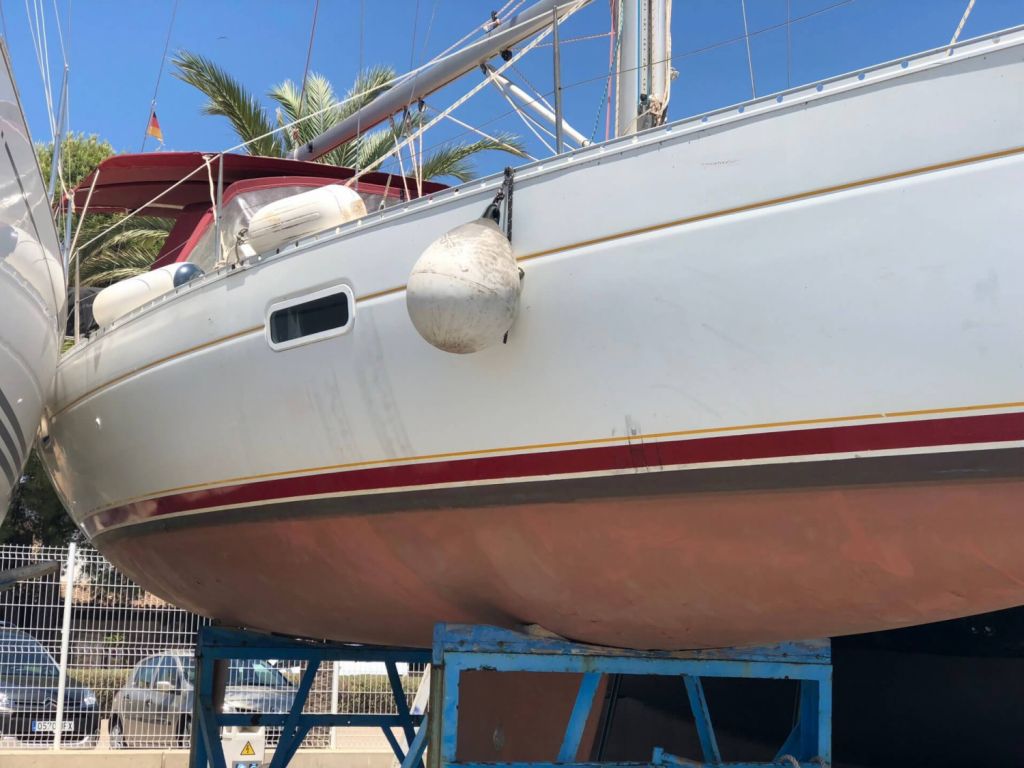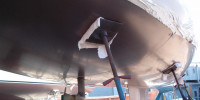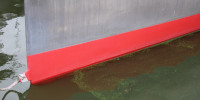How Much Does it Cost to Antifoul a Boat? (Bottom Paint)
Bottom painting is one of the many ongoing expenses you can plan for when you buy a boat. You don't have to do it every year, but unless you dry sail the boat or keep it in pristine fresh water, you will have to do it. It's not hard to figure out once you take all the factors in.
Painting the bottom of a moderate-sized boat in a yard will cost between $20 and $45 per foot. A 25-foot yacht will cost you around $800. A 40-foot yacht will cost you around $1,300. This cost ranges quite a lot because of many variables, but you can control some of those to rein in the costs.
Below, I'll go over the different variables that will affect the cost. Read on to learn how to save money.

On this page:
The Average Cost for Antifouling
To make things easier, I've created a table with the cost range for different boat lengths:
| boat length | min cost | max cost |
|---|---|---|
| 20 ft | $400 | $900 |
| 25 ft | $500 | $1,125 |
| 30 ft | $600 | $1,350 |
| 35 ft | $700 | $1,575 |
| 40 ft | $800 | $1,800 |
| 45 ft | $900 | $2,025 |
| 50 ft | $1000 | $2,250 |
What is Included in the Cost?
Typically, the following is included:
- Paint
- Labor
- Consumables
- Environmental, Insurance, and Disposal Charges
The specifics of any bid you receive to paint your bottom will vary from yard to yard. You need to be careful to read each quote carefully, as there are many small items you may find that add up. To antifoul a boat properly, there are several specific items that should be quoted in detail.
The yard may give you a quote stated on a per foot basis for your boat, or they may give you an estimate based on your boat specifics. I've had yards quote me per foot as an off-the-cuff estimate, then hand me a detailed bill at the end that doesn't really match the per foot estimate. I'd rather see an estimate for hours of labor and lists of materials.
Discuss what it includes before you accept the bid and start work so you understand the final bill.
Paint
The specific paint you choose will affect the end price, as paint quality and prices ranges from around $100 a gallon to close to $300. Most yards will estimate how many gallons you need, but you may find the final bill used more (or maybe less!) paint than the estimate included.
The yard should also help you choose a paint, but take care to research your needs yourself so you can make an informed decision and not put on a more expensive paint than you need.
Labor
The hourly rate for yard labor may shock you if this is your first boat. But even a task like bottom painting will cost a significant amount per hour. Most quotes for painting will be based on estimated hours, rather than exact hours.
If a marina quotes you "$35/foot" on a painting job, there should not be extra or excessive charges for labor on top of this. The exception is if there are problems found which require extra preparation or work. Most responsible yards will contact you if this happens.
Consumables
Rubber gloves, sandpaper, masking tape, protective masks, paint stirrers, and Tyvek suits are among the consumable items they may bill you for as part of a bottom job. It surprised me the first time I had a yard paint my boat to see a two page bill for just rolling on the paint. Don't assume the quote is for anything but paint and labor; make sure it includes consumables as these may add hundreds of dollars to the final bill.
Also, don't assume you'll be charged anything less than full retail price from the ship's store for these items, or that you will only pay for what they use. For example, if masking tape is used, you may see a charge for an entire roll. It is best to discuss these things in advance with the yard to avoid surprises.
Environmental, Insurance, and Disposal Charges
Many states and countries now leverage various environmental charges and fees associated with marina work. Bottom painting runs afoul of these because of the inherent toxicity of the paint. Yards usually pass these on to the boat owner. They may be a flat fee or a percentage of the total bill. Ask upfront what they will be and if they are mandatory.
What Drives the Cost Up?
What makes this job so expensive? Why is one boat so much more to antifoul than another? Bigger boats cost more to protect, this is unavoidable. But what else makes this
Size of the boat
A longer boat does not have a simple linear relationship between its length and the amount of paint it needs. My son's Capri 22 needed less than a gallon of paint for a thorough paint job; our fifty-three footer takes eight to ten gallons of the same paint for a proper application. We're two-and-a-half times the length, but twenty-five times the displacement.
So many yards have sliding scales on a per foot basis, with bigger boats costing more. The more the displacement of the boat, the more labor and materials it takes to paint it.
Prep Work and the Old Paint
Ideally, your last bottom job would need only a light cleaning and sanding before they apply new paint. Even this is a fair amount of labor. But conditions are rarely ideal.
Paint which is flaking or chipping may require additional preparation. This may mean sanding or filling to smooth flaked areas, and extra preparation where paint may have completely flaked off.
Bottoms with growth or encrustations may take considerably more time to make ready. The yard will pressure wash the bottom when the boat is hauled, but this will not take care of excessive growth. This is a strong argument for regular painting and occasional bottom scrubbing - it can save you a lot of money the next time you paint.
If you change the type or manufacturer of paint, the old paint may have to be completely removed. There may be compatibility issues between types and brands of paint - ignoring them can be an expensive mistake. Sometimes staying with the old brand even if it's not what you want may be a more affordable option if it is still available and legal to use.
Prep work also includes masking off the waterline and underwater gear. If spraying, this will include skirting the boat and protecting it from over-spray.
You should be given an estimate for the prep work needed. Once they start, if the labor will vary more than about 10% of this the yard should contact you to discuss it before proceeding.
Type of Paint
A full study on the types, brands and varieties of paint on the market is beyond this post, but you should be aware there is a considerable range of costs based on the bottom paint you choose. The least expensive bottoms paints are still expensive.
The cheapest paint may not be the best paint for your area or your usage plans. Some paints are more effective in certain regions of the world and this may justify the extra cost. The yard should have familiarity with which types of paints are most effective for local boats.
How to Save Some Money
The absolute cheapest way to antifoul your boat is to do it yourself. It costs you your weekends, not your dollars, and you only buy the supplies you need. If your boat isn't too large and the project manageable, this is a real alternative that a lot of boat owners use. The pros are the lower costs. The cons are that you are dealing with a lot of work with toxic substances and you need to be careful, for your health and for the environment.
If a yard will do the work for you, there are still some steps you can take to make it less expensive. Ways to do this include:
- Supply your own paint. Many yards will let you supply your own even if they are doing the work, and you can often get it for a better price if you buy it yourself. Note: not all yards sell all brands, so choosing a brand the yard does not supply usually requires this.
- Pick the cheaper paint. It may not last as long or be the best choice, but it will provide protection if you're pressed for cash.
- Do some prep work yourself. Sanding bottom paint is a nasty business, but you can do that. It requires elbow grease and protective equipment, but your own labor is cheap. Scrubbing the bottom before it comes out of the water is another way to shortcut preparation.
- Keep your bottom clean. Don't let hard or heavy growth accumulate, this gets very expensive to clean up.
- Paint on a schedule. This goes back to keeping your bottom clean, but if you don't let your paint completely wear out, then you will not have as much growth at the end of the season. If the paint says it's good for two seasons, repaint when you are supposed to.
- Spray vs. Roll. This is a question for your yard, but most yards have different prices for spraying paint versus rolling it as the labor and paint coverage rate is different.
Planning Your Project
The key to managing your costs is to understand the quotes you get from marinas. Check the following items off to make sure you have estimates so there are no surprises.
- Paint choice and quantity
- Labor hours - rates and estimated time
- Consumables - quantities and costs
- Environmental charges and fees.
Did you find the answer to your specific question?
👍 17 👎 0


Comments
Barrie Marfleet
What was the date this article was written? Thanks
Leave a comment